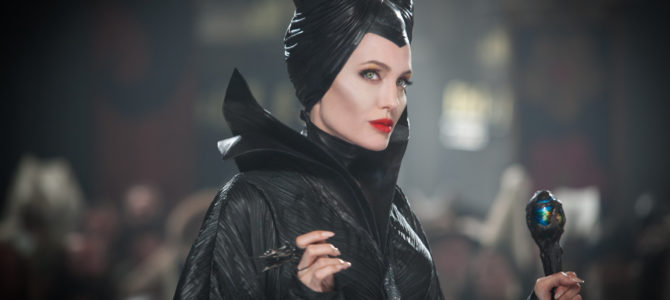
Some mild spoilers.
Disney’s “Maleficent: Mistress of Evil” hit theaters this weekend, with Angelina Jolie back in the title role. A sequel to the 2014 “Maleficent,” which unfolded the untold story of the 1959 animated classic “Sleeping Beauty,” this addition to the fairy tale picks up just in time for the dashing prince to propose to Aurora, a.k.a. Sleeping Beauty.
Aurora is no longer a princess; she’s been named queen of the Moors by her godmother Maleficent, who raised her. Tending to the Moors as sovereign is what’s been keeping Aurora busy all this time. There’s only one real problem with this fairy tale, and it’s a big one: There’s no love in the story.
Where’s the Love Story?
Sure, there’s a love story, but it’s well in the background, and only used for plot points, such as an engagement dinner and the wedding day. The prince comes by and proposes, swearing his undying love and proclaiming his devotion.
But a classic Disney romance means there’s true love, so much that the princess gets to go simply gaga over it. True love in a Disney story means being blissed out on the joy of being with another person, totally enthralled and delighted by his or her company. This is a love so strong that fairies spin around the princess’s head like stars, and sweet songs erupt from her throat unbidden.
Not so in “Maleficent: Mistress of Evil.” The love between Aurora and her forgettable prince is almost entirely political. Even in the first moment of his proposal, their conversation turns from their own joy and happiness to the glory of uniting their two kingdoms — his, the human one, and hers, the one with all the little fairies and whimsical mini porcupines. Her main goal in marrying him is this unification and establishing peaceful relations between the fairy kingdom, where walking trees look like skeletons, and the human realm, where a strict class system keeps the rulers in power.
The prince seems more in love than Aurora does, but only because he keeps insisting that his love is true, not because it’s ever evidenced. There are no grand gestures wherein he proves his spirit. It’s like the writers were so keen on making sure that Aurora was represented as a modern woman who is more concerned with career than love that they didn’t put any love in her heart at all.
It’s sort of sad, really, to see a woman sell herself into marriage as a political move, sacrificing her future because she thinks that’s what’s best for all the people depending on her. No matter how feminist and female-forward this movie is, it’s still the same old trope of the young lady giving it all for the benefit of others. Only instead of something like family honor, here it’s to fulfill her work.
Maleficent Reverses Good and Bad
In “Maleficent: Mistress of Evil,” we see a reversal of the expected understanding of good and evil. Everyone knows the evil queen is evil. She’s got the crazy magic, she’s got horns, she only wears black, and she doesn’t know how to smile. But in what has become a distinct, expected reversal, it’s the good queen in white who has the hardest heart. To understand why, we have look at the film from the perspective of that ghastly contemporary distraction, identity politics.
Maleficent’s world includes basically two kingdoms. The first is the human kingdom, with classic castles, turrets, flags that come to little points at the end, soldiers in armor, catapults, crossbows — it’s a total feudal paradise. The second is the natural kingdom, where Aurora and Maleficent hang out, with flowering trees, a throne made of branches, sunlight peeking through the forest canopy, birds singing.
In short, it’s an organic, wholesome wonderland. Although an adopted human wears the crown of the fairy realm, it’s a place for natives who were displaced from their original kingdom by those pesky humans, who have built up their environment, erected walls, and generally subsumed nature to their desires.
So natives: good. Colonizers: bad. That’s just common sense these days anyway, so it’s not an odd take. But it does explain why Maleficent, despite her impulse toward destruction, is portrayed as in the right, while the humans are in the wrong. Maleficent is the one who wants to keep everything peaceful. She’s the one who is willing to put aside her differences with the humans for the good of her adopted daughter. It isn’t until she’s betrayed, accused of doing evil to the hapless, ineffectual king, that she lashes out.
Politics Makes for a Boring Fairy Tale
This is when things start to get really interesting. Maleficent flees the human land and ends up falling in with a bunch of other dark fairies, as her kind is known. She finds herself in a big nesty cave-type place, where the last of their kind are all bunched together, scared of the nasty, colonizing humans.
These dark fairy creatures, all with wings, claws, and a penchant for body paint, take Maleficent in and encourage her to stop caring about humans and start standing up for her own kind. Their argument is compelling because they talk about how humans pushed them out of their ancestral home, hunted them to near extinction, and left them to be helpless victims just waiting for someone to come along and help them get vengeance.
These humans gobble up nature and have effectively ruined the environment for the magical, indigenous dark fairies. Extremists on both sides push for war, although it’s not really clear why the queen wants to kill all the fairies, nor why the dark fairies want to attack the humans, other than that they’re both out for vengeance. The war is just brutal combat between magical creatures with no weapons and humans who have weaponized the environment.
But even so, vengeance is not love. Feeling like you have to destroy someone because he destroyed you first is not love. Even while Aurora and her prince call out for peace, there’s no real clear idea about why the war is occurring in the first place.
Without love or aspirations to love, without longing in the heart for the unbridled attentions of another, the entire story is boring. Disney fairy tales are about striving for love, looking for it, finding it, and having it solve all the protagonist’s problems — at least for a little while, if not altogether happily ever after. There’s no love in this story, except a strident love of righteousness on the part of all the characters.
Once Aurora and her prince speak of love between them, there is no questioning, no insecurity, no “What if I like him better than he likes me?” unrest. There’s no agony to it, no longing, no thirst that must be quenched. In fact, it’s astounding how easy it is for these two to keep their hands, lips, and eyes off one another. The affair is more like a business transaction than a love story, because that’s all it is.
“Maleficent: Mistress of Evil” is a boring fairy tale that forgets what fairy tales are all about. Disney fairy tales are classically aspirational stories, not about politics, or world peace, or how we should all get along, but about love. Disney took the old Grimm’s fairy tales and turned them into something else, and now it’s like they’re trying to turn them back.
But what our culture needs is to remember what love actually is. It needs a story in which political alliances are meaningless, and all that really matters is true love’s kiss. Instead of trying to show us the dark side of fairy stories, Disney should remember it’s the light that keeps us coming back to theaters, not overly politicized moral dramas — that’s what the news is for.









